FEATURE ARTICLE - JOB SEARCH EXPERIENCE: METHODS AND BARRIERS IN FINDING JOBS
FEATURE ARTICLE - SPOTLIGHT ON COUNTRY OF BIRTH
FEATURE ARTICLE -SPOTLIGHT ON METHODS OF SETTING PAY
FEATURE ARTICLE - SPOTLIGHT ON MULTIPLE JOB HOLDERS
FEATURE ARTICLE - SPOTLIGHT ON OCCUPATION
FEATURE ARTICLE - SPOTLIGHT ON PARENTAL LEAVE
FEATURE ARTICLE - TECHNICAL REPORT: IMPROVEMENTS TO LABOUR FORCE ESTIMATES
FEATURE ARTICLE - TRADE UNION MEMBERSHIP
Notes
Changes in this issue
Labour Force Survey estimates for prior periods have been revised using updated population benchmarks based on results from the 2001 Census of Population and Housing, and incorporating a minor change to the definition of unemployed persons. See Technical Report: Improvements to labour force estimates in this issue.
Data contained in this issue
The statistics shown are the latest available at 22 March 2004. Data sources for the tables in this publication are listed in Appendix 1.
Electronic products
The spreadsheets and data cubes referenced in this publication are available on the ABS web site at https://www.abs.gov.au. Follow the links to Data Cubes and Time Series Spreadsheets.
Inquiries
For further information about these and related statistics, contact the National Information and Referral Service on 1300 135 070 or Erika Maxim on Canberra 02 6252 7636.
Labour Market Summary
Key measures
Employment: trend series
Full-time and total employment
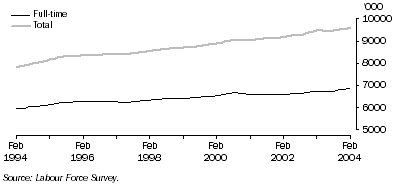 Males and females
Males and females

Part-time employment: trend series
Proportion of total employment, Males
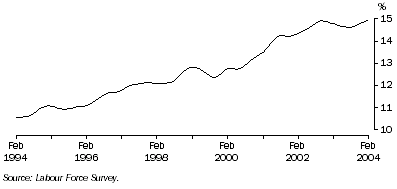 Proportion of total employment, Females
Proportion of total employment, Females

Unemployment rate: trend series
Males and females
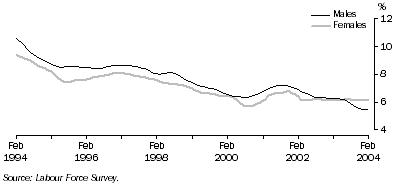
Long-term unemployment: trend series
Proportion of total unemployment

Underutilised labour
Labour underutilisation rates—1994–2002

Participation rate: trend series
Wage cost index: trend series
Total hourly rates of pay excluding bonuses, Quarterly change
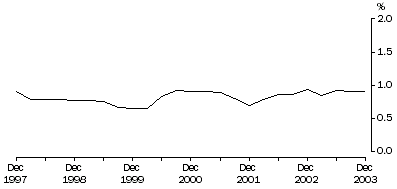
Average weekly earnings: trend series
Full-time adult ordinary time earnings, Quarterly change
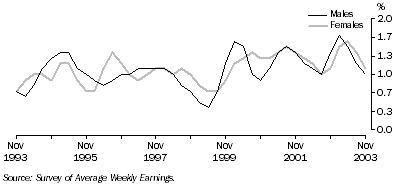 All employees total earnings, Level
All employees total earnings, Level
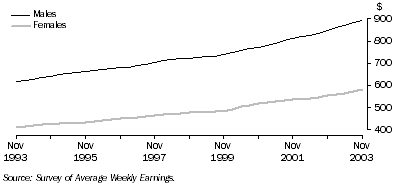
Industrial disputes: original series
Working days lost, Quarter ending

Job vacancies: trend series
Job vacancies, By sector

Labour statistics news
Labour theme page
The ABS Labour Theme Page, available on the ABS web site, provides a guide to the range of ABS labour statistics, as well as links to the latest data released. To find the Theme Page, go to https://www.abs.gov.au (Themes - Labour).
ABS email notification service
By subscribing to this free service, you will be kept informed via email of the latest releases of ABS products. To subscribe, follow the link from the ABS home page https://www.abs.gov.au, provide your email address, and select your topics of interest.
Changes to LFS unit record data
The ABS introduced a number of changes to labour force statistics with the release of February 2004 LFS data. These changes involved revisions to detailed original data at the unit record level which flowed through to published aggregated data. More information about these changes is available in Technical Report: Improvements to labour force estimates in this publication.
Implementation of computer assisted interviewing
In October 2003, the ABS began the progressive implementation of computer assisted interviewing (CAI) into the LFS. For the period October 2003 to January 2004 the CAI method was used on a random 10% sub-sample of survey interviews. The ABS had planned to increase the sub-sample of survey interviews conducted using the CAI method from 10% to 40% in February 2004. However, a number of technical problems have prevented this. The CAI sub-sample was increased from 10% to 40% in February 2004 in New South Wales, Victoria, South Australia and the Australian Capital Territory only. The effects of these technical problems may delay the full implementation of CAI.
Once the technical problems are resolved, subject to further analysis continuing to confirm that the change in method is not having a significant impact on survey estimates, the ABS intends to progressively increase the use of CAI. Users will continue to be informed of the progress of CAI implementation, including the results of further analyses, through updates in Labour Force, Australia (cat. no. 6202.0).
Forthcoming changes to industrial disputes statistics
The December 2003 issue of Industrial Disputes, Australia (cat. no. 6321.0) is the final release of monthly statistics of industrial disputes. Statistics in this publication will continue to be available, but for a quarterly reference period. The printed publication will be replaced with a quarterly electronic publication (cat. no. 6321.0.55.001), commencing with the March quarter 2004 reference period. The quarterly publication will contain a small number of summary tables and will be available free from the ABS web site. More detailed data will continue to be available as electronic spreadsheets.
New classifications for Cause of Dispute and Reason Work Resumed (formerly Method of Settlement) will be introduced in the first quarterly publication. Data for the new classifications will be available for disputes which ended during the March quarter 2003 onwards. Further information is available from Colin Fallows on Perth 08 9360 5184.
Labour Costs
Results from the 2002-03 Survey of Major Labour Costs will be released in June 2004, in the electronic publication Labour Costs, Australia (cat. no. 6348.0.55.001). This survey provides estimates of labour costs including: employee earnings, employer-funded contributions to superannuation, workers' compensation, payroll tax and fringe benefits tax.
Regional wage and salary earner statistics
The electronic publication Characteristics of Wage and Salary Earners in Regions of Australia (cat. no. 6261.0.55.001) was released on 5 March 2004. This publication presents regional estimates of the characteristics of wage and salary earners for 2000-01 using the Remoteness Structure contained within the Australian Standard Geographical Classification (ASGC), Volume 1, 2001 (cat. no. 1216.0). The estimates were compiled from the Australian Taxation Office's Individual Income Tax Return Database. This publication follows the release in December of Regional Wage and Salary Earner Statistics, Australia (cat. no. 5673.0.55.001), which used the same data source to produce estimates for wage and salary earners for Local Government Areas for 2000-01.
Supplementary surveys on labour topics
The Monthly Population Survey comprises the Labour Force Survey and supplementary surveys, which provide detailed information on a range of topics. Results from surveys on labour-related topics recently released were: Employee Earnings, Benefits and Trade Union Membership, Australia (cat. no. 6310.0); Persons Not in the Labour Force, Australia (cat. no. 6220.0); Underemployed Workers, Australia (cat. no. 6265.0); and Job Search Experience, Australia (cat. no. 6222.0). The first three of these releases are outlined in the recent release section of this publication. Also included is a feature article highlighting the data available from the Job Search Experience survey.
Upcoming statistical releases |
|  |
| Release date/title of publication |  | Reference period | Catalogue number |  |
|  |
| April 2004 |  |  |  |
 | Australian Labour Market Statistics | April 2004 | 6105.0 |  |
 | Indigenous Social Survey | 2002 | 4714.0 |  |
 | Job Vacancies, Australia | February 2004 | 6354.0 |  |
 | Labour Force, Australia | March 2004 | 6202.0 |  |
 | Labour Force, Australia - Detailed Delivery | March 2004 | 6291.0.55.001 |  |
 | Measures of Australia's Progress | 2004 | 1370.0 |  |
| May 2004 |  |  |  |
 | Average Weekly Earnings, Australia | November 2003 | 6302.0 |  |
 | Labour Force, Australia | April 2004 | 6202.0 |  |
 | Labour Force, Australia - Detailed Delivery | April 2004 | 6291.0.55.001 |  |
 | Labour Statistics in Brief, Australia | 2004 | 6104.0 |  |
 | Wage Cost Index, Australia | March quarter 2004 | 6345.0 |  |
| June 2004 |  |  |  |
 | Industrial Disputes, Australia - electronic release | December 2003 | 6321.0.55.001 |  |
 | Labour Costs, Australia - electronic release | 2002-03 | 6348.0.55.001 |  |
 | Labour Force, Australia | May 2004 | 6202.0 |  |
 | Labour Force, Australia - Detailed Delivery | May 2004 | 6291.0.55.001 |  |
 | Wage and Salary Earners, Public Sector, Australia | March quarter 2004 | 6248.0.55.001 |  |
| July 2004 |  |  |  |
 | Australian Labour Market Statistics | July 2004 | 6105.0 |  |
 | Family Characteristics | June 2003 | 4442.0 |  |
 | Household Income and Income Distribution, Australia | 2002-03 | 6523.0 |  |
 | Job Vacancies, Australia | May 2004 | 6354.0 |  |
 | Labour Force, Australia | June 2004 | 6202.0 |  |
 | Labour Force, Australia - Detailed Delivery | June 2004 | 6291.0.55.001 |  |
|  |
 Print Page
Print Page
 Print All
Print All